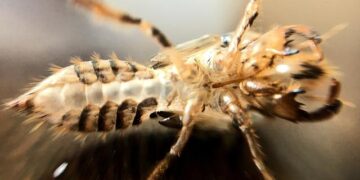Introduction
Welcome to the Health Canada Pest Management Regulatory Agency’s Vertical Farming Stakeholder Questionnaire. The Pest Management Regulatory Agency (PMRA) is the Canadian government agency responsible for the regulation of pest control products, or pesticides, in Canada. To participate in the questionnaire, you should be either an owner or operator of a commercial vertical farm in Canada. One response only per vertical farm is requested.
What kind of information is being sought?
The purpose of this questionnaire is to obtain a snapshot of the vertical farming industry that will help inform the PMRA’s strategy to support the safe and effective use of pest control products in commercial vertical farming facilities.
You will be asked for information about aspects of your growing facility, production system, crops and pest pressures.
The PMRA will use the information gathered with this questionnaire to develop an appropriate approach to assess potential exposure and risks associated with the use of pest control products.
There are currently no pest control products registered for use in vertical farming operations in Canada. For more information, see Information Note: Vertical farming and pest control products (Appendix A).
What does Health Canada/PMRA consider to be a vertical farm?
To determine if your facility would be considered a vertical farm, please consult the following features of a vertical farm:
produces crops grown in appropriate media, for instance hydroponically, aeroponically or in soil;produces crops grown indoors on vertically stacked or inclined layers and/or integrated in other vertical structures, andrelies solely or largely on artificial lighting.
Can a greenhouse be a vertical farm?
Vertical farming differs from greenhouse production. In a greenhouse, plants are generally grown in a single layer on horizontal benches, containers or troughs placed on the ground and rely largely on natural sunlight. Vines, like tomato or cucumber plants, may grow vertically but are not considered vertically farmed if all plants are placed on one layer.
If you wish to participate in the questionnaire but are uncertain if your facility would be characterized as a vertical farm, please feel free to contact the questionnaire team at [email protected] for clarification.
What is a pesticide in the context of this questionnaire?
A pesticide or pest control product is any product used to directly or indirectly control, destroy, attract or repel a pest or prevent the pest’s injurious, noxious or troublesome effects.Pest control products contain active ingredients that can be substances, living organisms (for example, a beneficial species of bacteria or fungi) or other materials (ozone, chemical fungicide/insecticides) that exert these effects.Pest control products may be applied to plants or soil, or be used for surface, air or water sanitization in the presence or absence of crops.In Canada, pest control products are identified by a Pest Control Products Act (PCPA) registration number, which will appear on the product label in this format:
‘Registration number: ##### Pest Control Products Act’
Participation in the questionnaire
Thank you for taking time from your schedule to participate.
Pesticide free? If your goal is to produce vertically farmed crops without the use of pesticides, we also would like to hear from you. The goal of the questionnaire is to understand the vertical farming industry in Canada, which includes vertical farms that are “pesticide-free”.
By providing your responses to the questionnaire, you acknowledge that your participation in the questionnaire is voluntary, and you are at least 18 years of age. You may choose to terminate your participation in the questionnaire at any time and for any reason by contacting the questionnaire team at [email protected].
Any personal information (names and contact information) provided as part of the data collection process will not be used to inform decisions or be made publicly available. Please see the Privacy Notice.
START OF THE QUESTIONNAIRE
PLEASE FEEL FREE TO SKIP QUESTIONS IF YOU DO NOT KNOW OR DO NOT WISH TO PROVIDE AN ANSWER.
The questionnaire should take about 25 minutes to complete.
The following questions relate to pest pressures in the vertical farm. Pest pressures affect the type of pesticides that may be useful in a vertical farm, the frequency of their use and their efficacy. Your answers to these questions will help the PMRA understand existing needs and focus resources and efforts.
1. Please rate your level of interest in the following pesticide types for use in the vertical farm.
Level of Interest : 0=not interested, 5=highly interested.
Select ‘0’ for all choices if no pesticides will be used in your vertical farm.
Select ‘ND’ if you are undecided or you do not wish to respond.
*Microbial biopesticides contain living microorganisms or viruses that are used for pest management. They do not include predatory or parasitic insects/mites used for biological control.
*Non-conventional pesticides include food items, extracts, preservatives or additives (e.g. garlic powder); plant extracts and oils (e.g. vegetable or mineral oils); commodity chemicals that have a range of non-pesticidal uses (e.g. acetic acid, table salt, citric acid); fertilizer or other plant growth supplements commonly used in the agricultural sector (e.g.mineral salts, such as sodium, and potassium salts of phosphorus acid); or inert materials (e.g. diatomaceous earth) that have pesticidal uses.
*Conventional pesticides include chemicals that are synthesized by industry for pest management purposes.
*Surface sanitizers for equipment’ are pesticides that are meant to be applied to hard structures in the plant production area to prevent or control pests. While they may be applied either in the presence or absence of plants, they are not intended for application to plants.
*Air or water sanitizers’ are pesticides that are released into the air or water in the plant production area to prevent or control pests that live or move there. While they may be applied either in the presence or absence of plants, they are not intended for application to plants. Includes UV devices but does not include physical sanitization devices like a HEPA filter.
*Post harvest clean-up refers to application of pesticides (spray or fog) to plant material after the crop has been fully harvested but before the unusable plant material has been removed.
Comments on questions 1 a-f (optional):
2. In your past experience, what level of severity has typically resulted from different types of infestations in your facility?
Typical levels of severity in crop loss percentages. Select 0% if infestations have not occurred or have not resulted in any measurable crop loss.
Comments on question 2a-b (optional):
Questions related to work in the facility. When working with pesticides it is important that all aspects of worker exposure are considered in the human health risk assessment. The following questions will help determine exposure scenarios and the mitigation measures that could be considered feasible to protect workers.
3. To determine the potential exposure that workers may have to pesticide residues, it is important to know what sort of hand labour tasks are required for your crops. Select the following hand labour tasks that are required in your vertical farm.
3. To determine the potential exposure that workers may have to pesticide residues, it is important to know what sort of hand labour tasks are required for your crops. Select the following hand labour tasks that are required in your vertical farm.
No hand labour tasks are required
3. To determine the potential exposure that workers may have to pesticide residues, it is important to know what sort of hand labour tasks are required for your crops. Select the following hand labour tasks that are required in your vertical farm.
Pinching
3. To determine the potential exposure that workers may have to pesticide residues, it is important to know what sort of hand labour tasks are required for your crops. Select the following hand labour tasks that are required in your vertical farm.
Pruning
3. To determine the potential exposure that workers may have to pesticide residues, it is important to know what sort of hand labour tasks are required for your crops. Select the following hand labour tasks that are required in your vertical farm.
Tying
3. To determine the potential exposure that workers may have to pesticide residues, it is important to know what sort of hand labour tasks are required for your crops. Select the following hand labour tasks that are required in your vertical farm.
Transplanting
3. To determine the potential exposure that workers may have to pesticide residues, it is important to know what sort of hand labour tasks are required for your crops. Select the following hand labour tasks that are required in your vertical farm.
Scouting
3. To determine the potential exposure that workers may have to pesticide residues, it is important to know what sort of hand labour tasks are required for your crops. Select the following hand labour tasks that are required in your vertical farm.
Weeding
3. To determine the potential exposure that workers may have to pesticide residues, it is important to know what sort of hand labour tasks are required for your crops. Select the following hand labour tasks that are required in your vertical farm.
Hand harvesting
3. To determine the potential exposure that workers may have to pesticide residues, it is important to know what sort of hand labour tasks are required for your crops. Select the following hand labour tasks that are required in your vertical farm.
Other
Comments on questions 3 (optional):
Comments on question 4 (optional):
5. Personal protective equipment (PPE) is any clothing or equipment that is worn to minimize pesticide exposure and protect your health. PPE is always required when handling commercial or restricted class products; however, the level of PPE will vary depending on the toxicity, formulation, activity and extent of exposure.
Given the variability in vertical farm structures and tasks that are required in your facility, this question addresses whether certain types of PPE are feasible for workers to wear while mixing, loading and applying pesticides.
For your facility, select all personal protective equipment (PPE) that are considered feasible.:
5. Personal protective equipment (PPE) is any clothing or equipment that is worn to minimize pesticide exposure and protect your health. PPE is always required when handling commercial or restricted class products; however, the level of PPE will vary depending on the toxicity, formulation, activity and extent of exposure.
Given the variability in vertical farm structures and tasks that are required in your facility, this question addresses whether certain types of PPE are feasible for workers to wear while mixing, loading and applying pesticides.
For your facility, select all personal protective equipment (PPE) that are considered feasible.:
Chemical resistant coveralls over long-sleeved shirt, long pants, chemical resistant footwear, chemical resistant gloves
5. Personal protective equipment (PPE) is any clothing or equipment that is worn to minimize pesticide exposure and protect your health. PPE is always required when handling commercial or restricted class products; however, the level of PPE will vary depending on the toxicity, formulation, activity and extent of exposure.
Given the variability in vertical farm structures and tasks that are required in your facility, this question addresses whether certain types of PPE are feasible for workers to wear while mixing, loading and applying pesticides.
For your facility, select all personal protective equipment (PPE) that are considered feasible.:
Coveralls (cotton) over long-sleeved shirt, long pants, chemical resistant footwear, chemical resistant gloves
5. Personal protective equipment (PPE) is any clothing or equipment that is worn to minimize pesticide exposure and protect your health. PPE is always required when handling commercial or restricted class products; however, the level of PPE will vary depending on the toxicity, formulation, activity and extent of exposure.
Given the variability in vertical farm structures and tasks that are required in your facility, this question addresses whether certain types of PPE are feasible for workers to wear while mixing, loading and applying pesticides.
For your facility, select all personal protective equipment (PPE) that are considered feasible.:
Long sleeved shirt, long pants, and chemical resistant gloves
5. Personal protective equipment (PPE) is any clothing or equipment that is worn to minimize pesticide exposure and protect your health. PPE is always required when handling commercial or restricted class products; however, the level of PPE will vary depending on the toxicity, formulation, activity and extent of exposure.
Given the variability in vertical farm structures and tasks that are required in your facility, this question addresses whether certain types of PPE are feasible for workers to wear while mixing, loading and applying pesticides.
For your facility, select all personal protective equipment (PPE) that are considered feasible.:
Chemical resistant headgear (Sou’ Wester hat, chemical-resistant rain hat or large brimmed waterproof hat and hood with sufficient neck protection)
5. Personal protective equipment (PPE) is any clothing or equipment that is worn to minimize pesticide exposure and protect your health. PPE is always required when handling commercial or restricted class products; however, the level of PPE will vary depending on the toxicity, formulation, activity and extent of exposure.
Given the variability in vertical farm structures and tasks that are required in your facility, this question addresses whether certain types of PPE are feasible for workers to wear while mixing, loading and applying pesticides.
For your facility, select all personal protective equipment (PPE) that are considered feasible.:
Respirator
5. Personal protective equipment (PPE) is any clothing or equipment that is worn to minimize pesticide exposure and protect your health. PPE is always required when handling commercial or restricted class products; however, the level of PPE will vary depending on the toxicity, formulation, activity and extent of exposure.
Given the variability in vertical farm structures and tasks that are required in your facility, this question addresses whether certain types of PPE are feasible for workers to wear while mixing, loading and applying pesticides.
For your facility, select all personal protective equipment (PPE) that are considered feasible.:
SCBA: Self-contained breathing apparatus with a full facepiece.
5. Personal protective equipment (PPE) is any clothing or equipment that is worn to minimize pesticide exposure and protect your health. PPE is always required when handling commercial or restricted class products; however, the level of PPE will vary depending on the toxicity, formulation, activity and extent of exposure.
Given the variability in vertical farm structures and tasks that are required in your facility, this question addresses whether certain types of PPE are feasible for workers to wear while mixing, loading and applying pesticides.
For your facility, select all personal protective equipment (PPE) that are considered feasible.:
Protective eyewear (goggles or face shield)
5. Personal protective equipment (PPE) is any clothing or equipment that is worn to minimize pesticide exposure and protect your health. PPE is always required when handling commercial or restricted class products; however, the level of PPE will vary depending on the toxicity, formulation, activity and extent of exposure.
Given the variability in vertical farm structures and tasks that are required in your facility, this question addresses whether certain types of PPE are feasible for workers to wear while mixing, loading and applying pesticides.
For your facility, select all personal protective equipment (PPE) that are considered feasible.:
None of the abovementioned PPE are feasible (with text input for explanation)
Comments on question 5 (optional):
6. Were pesticides to be registered for use in vertical farming, each product would have a restricted entry interval (REI), which is the period of time that agricultural workers, or anyone else, must not enter to do hand labour in treated areas after a pesticide has been applied. This is to allow residues and vapours to dissipate to safe levels for work to be performed.
What is the longest REI that would be feasible for your facility?
6. Were pesticides to be registered for use in vertical farming, each product would have a restricted entry interval (REI), which is the period of time that agricultural workers, or anyone else, must not enter to do hand labour in treated areas after a pesticide has been applied. This is to allow residues and vapours to dissipate to safe levels for work to be performed.
What is the longest REI that would be feasible for your facility?
12 hours
6. Were pesticides to be registered for use in vertical farming, each product would have a restricted entry interval (REI), which is the period of time that agricultural workers, or anyone else, must not enter to do hand labour in treated areas after a pesticide has been applied. This is to allow residues and vapours to dissipate to safe levels for work to be performed.
What is the longest REI that would be feasible for your facility?
1 day
6. Were pesticides to be registered for use in vertical farming, each product would have a restricted entry interval (REI), which is the period of time that agricultural workers, or anyone else, must not enter to do hand labour in treated areas after a pesticide has been applied. This is to allow residues and vapours to dissipate to safe levels for work to be performed.
What is the longest REI that would be feasible for your facility?
2 days
6. Were pesticides to be registered for use in vertical farming, each product would have a restricted entry interval (REI), which is the period of time that agricultural workers, or anyone else, must not enter to do hand labour in treated areas after a pesticide has been applied. This is to allow residues and vapours to dissipate to safe levels for work to be performed.
What is the longest REI that would be feasible for your facility?
More than 2 days
Comments on question 6 (optional):
7. If required, could your facility adhere to at least one of the six following ventilation requirements:
Do not enter the treated area until after one of the following conditions is met:
Ten air exchanges are completed.Two hours of ventilation using fans or other mechanical ventilating systems.Four hours of ventilation using vents, windows, or other passive ventilation.Eleven hours with no ventilation followed by one hour of mechanical ventilation.Eleven hours with no ventilation followed by two hours of passive ventilation.Twenty-four hours with no ventilation.
Comments on question 7 (optional):
8. Were pesticide products to be registered for use in vertical farming, what type of equipment would be used to apply pesticides to crops in your vertical farm? (select all that apply)
8. Were pesticide products to be registered for use in vertical farming, what type of equipment would be used to apply pesticides to crops in your vertical farm? (select all that apply)
Fully automated stationary fogger (worker sets equipment in place and does not re-enter during the application time)
8. Were pesticide products to be registered for use in vertical farming, what type of equipment would be used to apply pesticides to crops in your vertical farm? (select all that apply)
Handheld fogger (equipment is carried, pushed, or pulled by a worker during the application)
8. Were pesticide products to be registered for use in vertical farming, what type of equipment would be used to apply pesticides to crops in your vertical farm? (select all that apply)
Semi-automated horizontal or vertical air-assist boom sprayer (worker places the equipment onto a track system and it sprays a certain distance, at which time the worker moves it to another track as required)
8. Were pesticide products to be registered for use in vertical farming, what type of equipment would be used to apply pesticides to crops in your vertical farm? (select all that apply)
Handheld mistblower/airblast (air-assist) (equipment is carried, pushed, or pulled by a worker during the application)
8. Were pesticide products to be registered for use in vertical farming, what type of equipment would be used to apply pesticides to crops in your vertical farm? (select all that apply)
Fully automated air-assist sprayer (worker not required to physically move the sprayer at any time during the application)
8. Were pesticide products to be registered for use in vertical farming, what type of equipment would be used to apply pesticides to crops in your vertical farm? (select all that apply)
Spray or drip using the irrigation system (pesticide is mixed, then loaded into the irrigation system and a worker does not need to be present during application)
8. Were pesticide products to be registered for use in vertical farming, what type of equipment would be used to apply pesticides to crops in your vertical farm? (select all that apply)
I don’t know
8. Were pesticide products to be registered for use in vertical farming, what type of equipment would be used to apply pesticides to crops in your vertical farm? (select all that apply)
Pesticides will not be used in the facility.
8. Were pesticide products to be registered for use in vertical farming, what type of equipment would be used to apply pesticides to crops in your vertical farm? (select all that apply)
Other (with text entry)
Comments on question 8 (optional):
The following questions relate to the application of pesticides in vertical farming facilities and potential routes for release of pesticide residues to the environment.
*A closed loop chemigation system consists of drench or irrigation application where any excess chemigation liquid is captured via trough, drainage tile, or other similar conveyance system, rather than allowed to percolate into the ground.
15. If your facility discharges drainage water/wastewater, typically how frequently is it released?
Comments on questions 9 to 15 (optional):
The following questions are general in nature. Responses to these questions will contribute to PMRAs knowledge of the types of vertical farms in Canada and typical growing practices.
Comments on question 16 (optional):
Comments on question 17 (optional):
Comments on question 18 (optional):
19. If plants are horizontally stacked, how many layers are there per stack?
Provide a range if the number of layers varies throughout the facility (for example, 5 to 10 layers per stack)
Comments on question 19 (optional):
20. What is the estimated total production surface area of your vertical farming facility (please specify square metres or square feet).
21. What is the floor surface area of your facility (please specify square metres or square feet).
Comments on question 22 (optional):
The following questions are related to the types of crops grown in a vertical farm and how they are being grown. Responses to these questions will contribute to PMRAs knowledge of crop production practices relevant to pesticide use.
24. What crops does your vertical farming facility produce, or intend to produce? (Select all that apply)
24. What crops does your vertical farming facility produce, or intend to produce? (Select all that apply)
Microgreens
24. What crops does your vertical farming facility produce, or intend to produce? (Select all that apply)
Lettuce
24. What crops does your vertical farming facility produce, or intend to produce? (Select all that apply)
Arugula
24. What crops does your vertical farming facility produce, or intend to produce? (Select all that apply)
Spinach
24. What crops does your vertical farming facility produce, or intend to produce? (Select all that apply)
Kale
24. What crops does your vertical farming facility produce, or intend to produce? (Select all that apply)
Chard
24. What crops does your vertical farming facility produce, or intend to produce? (Select all that apply)
Herbs
24. What crops does your vertical farming facility produce, or intend to produce? (Select all that apply)
Edible flowers
24. What crops does your vertical farming facility produce, or intend to produce? (Select all that apply)
Strawberries
24. What crops does your vertical farming facility produce, or intend to produce? (Select all that apply)
Cannabis grown to the flowering stage
24. What crops does your vertical farming facility produce, or intend to produce? (Select all that apply)
Cannabis transplants
24. What crops does your vertical farming facility produce, or intend to produce? (Select all that apply)
Transplants of any crop for use in a vertical farm
24. What crops does your vertical farming facility produce, or intend to produce? (Select all that apply)
Transplants of any crop for use in a field
24. What crops does your vertical farming facility produce, or intend to produce? (Select all that apply)
Transplants of any crop for use in a greenhouse
24. What crops does your vertical farming facility produce, or intend to produce? (Select all that apply)
Animal feed
24. What crops does your vertical farming facility produce, or intend to produce? (Select all that apply)
Other (with text entry)
25. What is the typical growing cycle for each of the crops you are growing?
How many crop cycles are completed in a calendar year for each specific crop?
What is the approximate time from harvest to sale for each crop?
Example:
Spinach; cycle length 1 month; 4 crop cycles per year; interval from harvest to sale 2 days
Comments on question 25 (optional):
26. If you grow more than one crop at a time, how many different crops are grown simultaneously? Provide a range if the number of crops grown simultaneously varies (for example, 2 to 5 crops are grown simultaneously).
The following questions are related to the production system. Your answers will help the PMRA understand aspects of crop production in vertical farms that could influence risks associated with pesticide use.
*In the context of this questionnaire, automation refers to software, equipment and other technology that performs work within the production system including physical labour or other actions either autonomously or in concert with facility employees.
Comments on question 29 (optional):
30. During plant growth, what are the maximum, minimum and average temperatures (degrees Celsius) in your vertical farm?
Maximum temperature (degrees Celsius)
Minimum temperature (degrees Celsius)
Average temperature (degrees Celsius)
32. Is there any additional information that was not covered in the questionnaire that you think might be important for the PMRA to consider when assessing the risks and value of pesticide products for use in vertical farms?
33. Do you have any (other) comments you would like to share with us?
END OF THE QUESTIONNAIRE
Thank you for your time and effort in completing the questionnaire.
Full name
Phone number
For example: 111-222-3333
Email address (required)
For example: [email protected]
Privacy Notice
The personal information you provide to Health Canada be collected by the Pest Management Regulatory Agency under the Pest Control Products Act, section 42.1, and handled in accordance with the Privacy Act. Your decision to participate or not is yours alone and there will be no consequences if you decide not to participate.
Why are we collecting your personal information?
Names and contact information submitted with the responses will be used to organize information. Responses will be collected to inform the development of policies and guidelines for pesticide use on vertical farms and not for any other purpose without the consent of the respondent.
Will we use or share your personal information for any other reason?
Your email address will be retained to contact you in the of event of an access to information request. Responses to the questionnaire will be protected under the Access to Information Act. Information in this questionnaire may be aggregated into a report that may be made publicly available.
What are your rights?
You have a right to complain to the Privacy Commissioner of Canada if you feel your personal information has been handled improperly. For more information about these rights, or about how we handle your personal information, please contact the (PMRA contact info for vertical farming questionnaire).
For more information: The collection of your personal information is described in Info Source. Refer to the Outreach Activities personal information bank (PSU 938)
>>> Read full article>>>
Copyright for syndicated content belongs to the linked Source : Canada.ca – https://forms-formulaires.alpha.canada.ca/en/id/cls0q0ppd000sxi82ty70ogaz






























